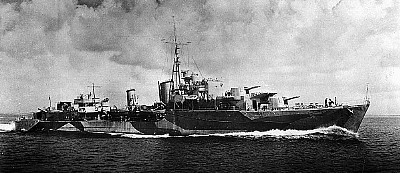Missing – One Destroyer
On the night of April 28, 1944, two Tribal Class destroyers, HMCS Haida and HMCS Athabascan, left Plymouth on a patrol of the E-boat infested French coast. Visibility was poor, a heavy fog having descended over the English Channel. The two ships took up their patrol eleven miles off the French coast, taking advantage of the poor visibility by running closer to the coastline than usual. With Haida in the lead position, two hours of uneventful cruising passed, the ships steaming at fourteen knots at their stations, while ammunition and fire fighting parties were at the semi-ready alert.

Shortly after midnight, the patrol reached Cape Ill-de-Bas. Full action stations was suddenly sounded, when an enemy ship was contacted by radar. The two destroyers immediately took up position of attack and proceeded to fire by radar direction. Soon afterwards, the enemy came into view and could be seen burning fiercely but before steps could be taken to close with the blazing vessel, Athabascan was hit. A shell, later proved to be from shore-based batteries, had struck the destroyer just aft of the bridge and had exploded. In a flash, searing flames flared up exposing the ship to the fullest view. Athabascan quickly signaled that the fire could be brought under control and Haida instantly proceeded to lay a smoke-screen to obscure the burning ship from further enemy view. Following her prompt laying of the smoke-screen, Haida resumed her fire against the enemy ship which was attempting to escape by steaming shoreward. After a short chase and a few well aimed salvoes, the enemy ship was seen to split apart and sink. Haida now made speed to return to Athabascan but before reaching the stricken ship, a terrific explosion was heard and a great blast of flame leaped heavenward from the spot where the mortally wounded ship was lying. The great flash lasted only a few seconds then all became darkness.
Haida reached the spot in a few short minutes and slowed to a crawl keeping a sharp lookout for any possible survivors. Suddenly the sea seemed to become full of twinkling lights that blinked from the headpieces of the life-jackets. Nosing her way to the centre of these beckoning lights, the ship stopped and life-rafts, floats, boats, and scramble-nets were put over the sides. As all hands turned to the immediate assistance of the survivors, men hung from the scramble-nets reaching to help the burned, oil-covered, shock-stricken men in the water. Cries for help could be heard from all directions. Many of the survivors were blinded, some so badly burned that the use of their hands and limbs were impossible. The stricken men's great feeling of hope was to be short-lived as code messages were received by Haida warning her that the squadron of E-boats was in the vicinity and headed her way. The ship being in imminent danger, orders were sent from the bridge to clear her sides. Nosing out of the patch of blinking lights as carefully as possible, the ship headed at full speed for the English coast. The men standing on the stern watched with mingled and indescribable emotions as the bobbing lights faded quickly in the engulfing darkness. Who can imagine the feelings of those who were left behind as they watched their only hope of salvation speeding off into the night?
In war, time does not allow for meditations or thoughts. Gun crews and all departments were alerted again in readiness for the new danger. Oil-covered, cold and injured men had to be attended; clothes were cut completely off and patients wrapped in blankets. Blood plasma and sedatives were administered to those who needed them. As the patients began to lose their chill, the fumes from their oil-covered skins could be smelt, fumes that could cause serious fire. No smoking could be allowed despite the many requests from the injured men. Those who were able, wanted to talk, making anxious inquiries for pals and for details of the action. Oil-slick covered patients were completely unrecognizable to one another so self-introductions had to be made all around.
Having luckily escaped the danger, Haida reached Plymouth in the grey dawn and proceeded to Devonport Dockyard where ambulances, nurses, and doctors were waiting. As soon as the patients were put ashore, preparations were made to put to sea again, Tired and weary men set out to bring on and store ammunition and short hours later the gate-boat at Jenny Cliff reopened the harbour gates as Haida steamed through to resume her patrol of the French coast. Missing – was one destroyer.
Ernest Schoen, RCNVR.
Chief Steward, HMCS Haida.
1943-45.
Written for the Class Annual 1946 Tyee Prematriculaton School for Veterans, Victoria B.C.
For a more up-to-date account of the sinking of HMCS Athabaskan,
see this Wikipedia article.
See also this Wikipedia article on German E-boats.
Can you provide details or corrections?
Please email Charlie Dobie.